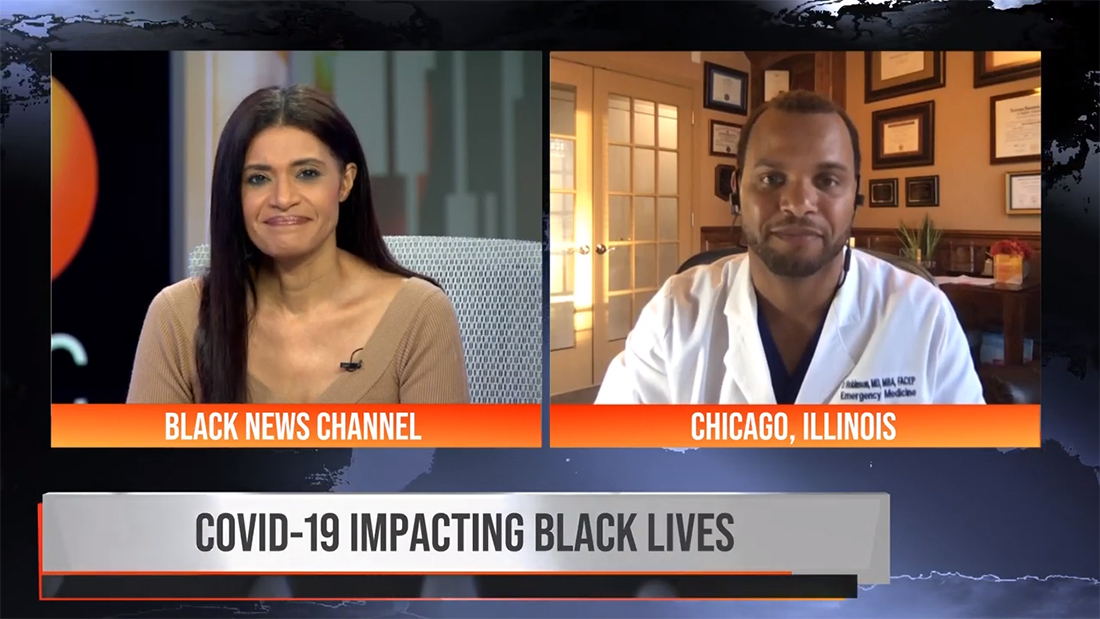Longstanding disparities in health conditions and social and economic experiences are magnifying the toll the COVID-19 pandemic is taking in black communities throughout the country.
Black Americans have made up 28% of reported COVID-19 cases even though they’re 13% of the population, according to preliminary data from the Centers for Disease Control and Prevention.
State and local numbers reinforce this stark trend. In Chicago, black residents have accounted for 36% of the city’s reported COVID-19 cases and 52% of deaths, although they make up 30% of the city’s population, according to the most recent data.
Statewide, 19% of COVID-19 patients whose race was known were black. Thirty-four percent of those who died were black, even though black residents make up 15% of the Illinois population.
These numbers don’t surprise health care professionals. Years of data and research indicate black people have poorer health outcomes and higher rates of death than whites for scores of conditions, including heart disease, stroke, colorectal cancer and pregnancy-related complications.
Black Americans and other demographic groups have long suffered in disproportionate numbers from health conditions that increase risk of severe illness from COVID-19 — heart and lung diseases, diabetes, immune deficiencies and obesity. Chicago officials say almost all city residents who have died from COVID-19 suffered from one or more of these chronic conditions.
However, health is only one factor to consider, says Dr. Derek Robinson, vice president and chief medical officer of Health Care Service Corporation's Illinois plan. Others include living in high-density housing and poor environmental conditions, relying on public transportation and holding essential jobs that don’t allow remote work — such as grocery store clerks, bus drivers and health care workers.
“African American, Hispanic and Native American communities have long experienced wide gaps in household income and household wealth,” Robinson says. “Experts have drawn a connection between more concentrated poverty, increased burden of chronic medical conditions which occur earlier in life, and the disparity in infection and death rates seen in this COVID-19 pandemic.”
Social determinants of health – access to quality education, employment, housing and nutritious foods – can influence the well-being of a community, and HCSC has supported initiatives to improve housing, health care and availability of healthy food in disadvantaged communities.
As a partner in the health care system, HCSC is working with medical schools and local and national organizations to improve diversify the physician workforce, as well as measure health outcomes and collaborate with doctors and hospitals to improve the quality of care they provide for all patients. In the long-term, these strategies may improve health outcomes in communities of color.
“We are partnering with providers to move beyond the moral imperative to reduce disparities in care and health."
“These are important steps which can make some difference in the next few years,” Robinson says. “However, as it has taken time to achieve many of the socioeconomic and health outcome gaps that persist today, enduring focus and durable interventions will be necessary to achieve health equity.”
For example, HCSC's Illinois plan is integrating health equity into value-based care arrangements with providers.
This means doctors and hospitals are rewarded for helping members improve their health, for example by ensuring they get recommended health screenings and control underlying conditions.
“We are partnering with providers to move beyond the moral imperative to reduce disparities in care and health,” Robinson says. “Disparities are more costly to our health care system. Working together, we can improve access to quality health care and achieve better health for all the communities we serve.”
Adding diversity to health care
Another step toward overcoming health disparities requires an examination of the physician workforce and the population it serves, Robinson says.
More than half of the children in the U.S. are expected to be part of a minority race or ethnic group this year, according to the U.S. Census Bureau. It’s a threshold the entire population is expected to reach by 2045.
Yet, more than half of all practicing doctors are white. Roughly 6% are Hispanic and Latino, and 5% are black.
People of color and different ethnic backgrounds often don’t have access to health care providers who look like them, speak their languages and understand the context of their needs, Robinson says.
“There is a degree of mistrust in the health care system, which has not always valued African American and Hispanic populations,” Robinson says. “If you don’t see people who look like you, you may believe that health care provider will not be as empathetic to you.”
Research shows a more diverse physician workforce could improve health outcomes. A 2018 study found that black men who saw black doctors sought more preventive services, including diabetes screening and cholesterol tests, compared with black men who saw non-black doctors. The researchers concluded that having more black doctors could reduce the gap in life expectancy between black and white men by 8%.
HCSC has supported efforts to diversify the health care profession pipeline through expansion of scholarship opportunities, internships and educational programs.
“This is one of the things we can do to help ensure our health care infrastructure is provided with a more diverse workforce, Robinson says. “Our relationships with academic medical centers and teaching hospitals give us a unique voice that can serve as a catalyst to drive significant improvement in physician diversity efforts.”


